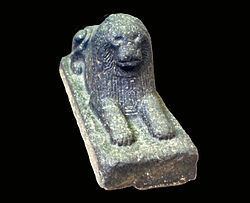Predecessor Sakir-Har Role King Monuments A Stela in Avaris Name Khyan Khyan | Children Yanassi Successor Apepi Died 1580 BC | |
 | ||
Reign 1610?–1580 BC (15th Dynasty) People also search for Apepi, Khamudi, Salitis, Sakir-Har | ||
Romantic Music
Seuserenre Khyan, Khian or Khayan was a king of the Hyksos Fifteenth dynasty of Egypt. His royal name Seuserenre translates as "The one whom Re has caused to be strong." Khyan bears the titles of an Egyptian king, but also the title ruler of the foreign land (heqa-khaset). The later title is the typical designation of the Hyksos rulers.
Contents
- Romantic Music
- Slipknot left behind drum duet cover johnkew khyan
- Khyans position in the Hyksos dynasty
- Origin of Khyans name
- References
Khyan is one of the better attested kings from the Hyksos period, known from many seals and seal impressions. Remarkable are objects with his name found at Knossos and Hattusha indicating diplomatic contacts with Crete and the Hittites. A sphinx with his name was bought on the art market at Baghdad and might demonstrate diplomatic contacts to Babylon.
The remains of a palace were recently excavated at Avaris. Seal impressions of Khyan were found there, indicating that this was his palace.
Slipknot left behind drum duet cover johnkew khyan
Khyan's position in the Hyksos dynasty
Khyan is identified with king Iannas in the works of Josephus whose knowledge of the Hyksos Pharaohs was derived from a history of Egypt written by Manetho. Josephus mentions him after Apophis when discussing the reign lengths of kings who ruled after Salitis. This led 18th century scholars such as Arthur Bedford to place Khyan after Apophis towards the end of the Hyksos dynasty. However, in Africanus' version of Manetho's Epitome, Khyan (whose name is transcribed there as Staan) is listed after a king Pachnan, perhaps Yaqub-Har. Stylistically Khyan's scarabs resemble closely those of Yaqub-Har, who might date rather to the beginning and not to the end of the Hyksos-period. This indicates that Khyan was one of the earlier rulers of the 15th dynasty.
The early position of Khyan within the 15th dynasty may be confirmed by new archaeological finds at Edfu. On this site were found seal impressions of Khyan in close connection with seal impressions of the 13th Dynasty king Sobekhotep IV, indicating that both kings could have reigned at about the same time. The scholars Moeller and Marouard discuss the discovery of an important early 12th dynasty Middle Kingdom administrative building in the eastern Tell Edfu area which was continuously employed into the early Second Intermediate Period before it fell out of use during the 17th dynasty when its remains were sealed by a large silo court. Fieldwork by Egyptologists in 2010 and 2011 into the remains of the former 12th dynasty building which was also used in the 13th dynasty led to the discovery of a large adjoining hall which proved to contain 41 sealings showing the cartouche of the Hyksos ruler Khyan together with 9 sealings naming the 13th dynasty king Sobekhotep IV. As Moeller and Marouard write: "These finds come from a secure and sealed archaeological context and open up new questions about the cultural and chronological evolution of the late Middle Kingdom and early Second Intermediate Period." These conclusions are rejected by Robert Porter who argues that Khyan ruled much later than Sobekhotep IV and that the seals of a pharaoh were used even long after his death. Another option he proposed is that Sobekhotep IV reigned much later as previously thought.
A stela of Khyan mentioning a king's son' was also discovered at Avaris. Manfred Bietak observed that: "a stela set up in Avaris contains the nomen and prenomen of Khyan and a now lost dedication (presumably to Seth, Lord of Avaris) below which are inscribed the title and name of the Eldest King's Son Yanassi."
The Danish Egyptologist Kim Ryholt, who published an extensive catalogue of the monuments of all the numerous pharaohs of the Second Intermediate Period, notes an important personal detail regarding this king's family; Ryholt writes that the association of Khyan with those of his eldest son upon this stela suggests that Yanassi in fact was his designated successor, as also implied by his title." Ryholt speculates that Manetho might have mentioned Yanassi in a now lost passage and that one possible explanation of the name Iannas used by Josephus for Khyan is a misquotation of such a passage in which the son's name was extracted instead of the father's.
Origin of Khyan's name
Ryholt notes that the name, Khyan, generally has been "interpreted as Amorite Hayanu (reading h-ya-a-n) which the Egyptian form represents perfectly, and this is in all likelihood the correct interpretation." It should be stressed that Khyan's name was not original and had been in use for centuries prior to the fifteenth Hyksos Dynasty. The name Hayanu is recorded in the Assyrian king lists—see "Khorsabad List I, 17 and the SDAS List, I, 16"--"for a remote ancestor of Shamshi-Adad I (c.1800 BC)."
